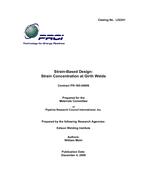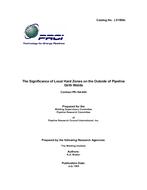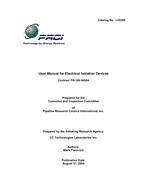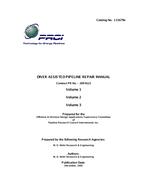Provide PDF Format
PRCI PR-185-04506
- Strain-Based Design: Strain Concentration at Welds
- Report / Survey by Pipeline Research Council International, 12/04/2006
- Publisher: PRCI
$48.00$95.00
L52241e
Edison Welding Institute
Need: Strain-based design is used for many situations for pipelines where the loadings from forces other than the internal pressure can be the largest generators of stress and strain in the pipe wall. Such loadings can be generated by soil subsidence, frost heave, thermal expansion and contraction, landslides, pipe reeling, pipe laying, and several other types of environmental loading. Designing based on strain for these cases has an advantage over designing based on stress because these loadings tend to apply a given displacement rather than a given force to the pipe. Standards are much better developed for stress-based design than for strain-based design. While several standards are available that have some coverage of strain-based design, there is a tendency to cover only limited types of loading, as in API RP 1111 for offshore pipe laying.
Result: This program aimed to improve guidelines for strain-based design of pipelines by studying cases with combinations of internal pressure and axial plastic strain in tension. Softened heat-affected zone (HAZ) regions have been observed to concentrate strain, particularly under internal pressure. HAZ softening has been observed for welds on X-70 and X-80 steels. Cases with little or no softening have also been observed for other welds in these same grades. This project extended these findings to X-100 steels, with cases of obvious softening and little or no softening observed. Higher heat inputs and larger weld volumes per pass associated with submerged arc welding (SAW) as compared to gas metal arc welding (GMAW) have been correlated with greater softening in each of these pipe grades.
Benefit: This project has demonstrated that the conditions required for the high strain concentration in the HAZ are dependent upon the configuration of the weld. Welds that meet the other criteria for high strain concentration but cannot fit a shear band at 45 degrees to the pipe axial direction into the softer material will not see the high strain concentration that was observed in the previous project. HAZ softening has been observed for welds on X-70 and X-80 steels. Cases with little or no softening have also been observed for other welds in these same grades. This project extended these findings to X-100 steels, with cases of obvious softening and little or no softening observed. Higher heat inputs and larger weld volumes per pass associated with SAW as compared to GMAW have been correlated with greater softening in each of these pipe grades.
Edison Welding Institute
Need: Strain-based design is used for many situations for pipelines where the loadings from forces other than the internal pressure can be the largest generators of stress and strain in the pipe wall. Such loadings can be generated by soil subsidence, frost heave, thermal expansion and contraction, landslides, pipe reeling, pipe laying, and several other types of environmental loading. Designing based on strain for these cases has an advantage over designing based on stress because these loadings tend to apply a given displacement rather than a given force to the pipe. Standards are much better developed for stress-based design than for strain-based design. While several standards are available that have some coverage of strain-based design, there is a tendency to cover only limited types of loading, as in API RP 1111 for offshore pipe laying.
Result: This program aimed to improve guidelines for strain-based design of pipelines by studying cases with combinations of internal pressure and axial plastic strain in tension. Softened heat-affected zone (HAZ) regions have been observed to concentrate strain, particularly under internal pressure. HAZ softening has been observed for welds on X-70 and X-80 steels. Cases with little or no softening have also been observed for other welds in these same grades. This project extended these findings to X-100 steels, with cases of obvious softening and little or no softening observed. Higher heat inputs and larger weld volumes per pass associated with submerged arc welding (SAW) as compared to gas metal arc welding (GMAW) have been correlated with greater softening in each of these pipe grades.
Benefit: This project has demonstrated that the conditions required for the high strain concentration in the HAZ are dependent upon the configuration of the weld. Welds that meet the other criteria for high strain concentration but cannot fit a shear band at 45 degrees to the pipe axial direction into the softer material will not see the high strain concentration that was observed in the previous project. HAZ softening has been observed for welds on X-70 and X-80 steels. Cases with little or no softening have also been observed for other welds in these same grades. This project extended these findings to X-100 steels, with cases of obvious softening and little or no softening observed. Higher heat inputs and larger weld volumes per pass associated with SAW as compared to GMAW have been correlated with greater softening in each of these pipe grades.





